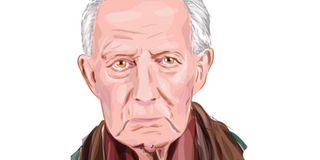How Achebe rescued ‘Weep Not, Child’

Keith Sambrook, 95, edited Ngugi wa Thiong’o’s Weep Not, Child. He now lives in the United Kingdom. ILLUSTRATION | JOHN NYAGAH
What you need to know:
- Pioneer novel’s editor reflects on Ngugi’s troubled beginnings which saw him overcome initial rejection from the short list of fame that then comprised Chinua Achebe, Cyprian Ekwensi and Peter Abrahams.
- Initially, in August 1962, Van Milne had told Ngugi that Weep Not, Child ‘‘was not quite up to the standard for the AWS.’’ However, with some intervention and encouragement from Achebe, Heinemann accepted it for inclusion in the Series ‘‘subject to some alteration.’’
- But then began negotiations, which delayed immediate further progress on publication in Weep Not, Child. Weep Not, Child was to be number 7 in the Series. The previous six titles included re-prints (in paperback) of novels by Achebe.
The unedited manuscript of Weep Not, Child by James Ngugi was handed over to me in January 1963, when I joined Heinemann Educational Books after 10 years at Thomas and Nelson, by my predecessor, Van Milne. It was destined for publication in the African Writers Series, recently launched by HEB with four titles, two by Chinua Achebe, who was also the Series general editor and adviser.
Chinua Achebe had seen the first draft in 1962 when he attended a literary conference at Makerere University College and met the student author. He was very impressed and recommended it to Heinemann for inclusion in the next batch of African Writers Series titles.
James Ngugi had already appeared in print with several contributions to the Makerere journal, Penpoint, as well as to the Sunday Nation. His play, The Black Hermit, had been performed at the Uganda National Theatre and an earlier novel, The Black Messiah (later to be published as The River Between) had been awarded top prize in the East African Literature Bureau’s creative writing competition.
NUMBER SEVEN
Achebe pointed out that Ngugi, at the age of 25, was already exhibiting the energy and variety of output of a professional writer.
Indeed, in the subsequent pre-acceptance correspondence with Heinemann, Ngugi said he was anxious for the decision on WNC because he wanted to work on a new novel “which will satisfy me.”
Initially, in August 1962, Van Milne had told Ngugi that Weep Not, Child ‘‘was not quite up to the standard for the AWS.’’ However, with some intervention and encouragement from Achebe, Heinemann accepted it for inclusion in the Series ‘‘subject to some alteration.’’ In November 1962, Heinemann apologised to Ngugi for delays in sending a formal letter contract but by December, one was offered. At this point, Weep Not, Child became my responsibility in Heinemann.
In March 1963, I sent a long detailed letter to Ngugi with proposed alterations in Chapters 1 and 2 with promise of further suggestions on Chapters 3 to 8, which had just arrived in the first draft from the author.
Ngugi’s response to my proposal was encouragingly friendly and accommodating and I wrote back thanking him for ‘‘taking our proposals calmly.’’
By October 1963, we had the first proofs. But then began negotiations, which delayed immediate further progress on publication in Weep Not, Child. Weep Not, Child was to be number 7 in the Series. The previous six titles included re-prints (in paperback) of novels by Achebe.
Both Alan Hill and Van Milne in Heinemann had conceived the Series for use by students in schools and colleges. Achebe, however, regarded it as offering the first real opportunity for the launching of new writing by new Africans.
In order to bring these new writers to the attention of critics and the general reader, the publication in ‘‘trade’’ hardback edition was necessary, accompanied by the full commercial royalty for the author.
FIRST CLASS REVIEWS
In the next few months I was engaged in discussion with Heinemann’s group publishing colleagues’ in William Heinemann (who had originally published Achebe).
Successfully, on January 1, 1964, Alan Hill was able to confirm to Ngugi that the Heinemann Group would bring out a hardback edition of Weep Not, Child, with full royalties, early 1964. In consequence, I had to write to Ngugi and say that the publication in the African Writers Series would have to be put back to May in order to allow William Heinemann a fair period of time to market the hardback successfully.
They did this well and Weep Not, Child received first class reviews in the Guardian and Times Literary Supplement and literary journals.
Weep Not, Child launched Ngugi on the first step of the ladder of international recognition and fame.
EDITOR’S NOTE: Keith Sambrook, 95, edited Ngugi wa Thiong’o’s Weep Not, Child. He now lives in the United Kingdom.




